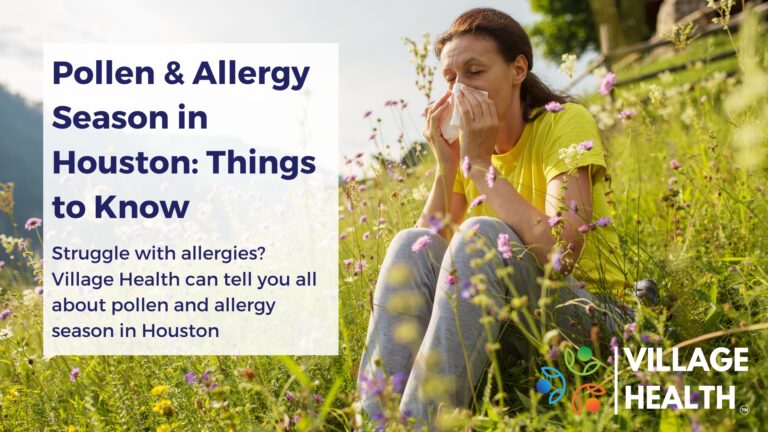
In this article we’re exploring spring allergies in Houston—the most common allergies, the worst season for allergies, and how to tell when it’s time to see a doctor about your allergies.
When is allergy season in Houston?
Houston is a great city for art, culture, and food. But thanks to its location on the balmy subtropical shores of the Gulf of Mexico, it’s also great for allergies—which isn’t so great.
Thanks to our warm, humid climate plants in the region pollinate almost year-round. So, unfortunately, allergy season never really ends in Houston. Luckily, for most of us, different plants pollinate at different times—so unless you are allergic to everything, the average person will not suffer allergy symptoms throughout the entire year.
The trick is finding which seasonal allergies affect you the most and marking your calendar accordingly—making sure to stock up on antihistamines when the date approaches.
Common Causes of Spring Allergies in Houston
Each season brings a new allergen, according to the Houston’s Health Departments allergy index, tree pollen is heaviest during the month of March. Common tree pollen creators include:
– Cedar Elm
Considered a moderate allergen, cedar elm (Ulmus crassifolia) is a wetland plant native to much of the southeastern United States, including the Houston-area. Though its pollen can trigger irritating symptoms for some, it is also used as a favored source of food for honey bees, Though bees are most famous for their honey, “bee bread”—packed, fermented pollen is an important source of nutrients for the little guys.
– White Ash
Considered a severe allergen according to pollenlibrary.com, White Ash (Fraxinus americana) is a popular source of wood used in the production of furniture, flooring and other everyday items and are grown commercially for these purposes.
– Elm
Elms are a family of trees found throughout the Northern Hemisphere in North America and Eurasia. Several species of elm are native to the Houston area, where they are considered a major source of allergies in Houston. Elm wood has been valued for centuries for its strength and durability—with uses ranging from wagon-wheel hubs to coffins. Many species of elm are used as ornamental trees. A smaller subset, such as the Slippery Elm, found in Houston, are valued for their pharmacological properties.
– Pecan
We have many things to thank pecan trees for—delicious pies and candies, luxurious canopies that provide much needed refuge from the hot southern sun, beautiful furniture and flooring, and hand strength for that small subset of the population brave enough to grab a handful and get to cracking. Unfortunately, these gifts come with one big catch—Pecan trees are highly allergic and can cause severe symptoms for those who are allergic.
– Oak
Oaks need no introduction—we all know what they are and what they do. Oak trees are an extremely large family of trees, numbering around 500 extended species with a history that stretches back to the time of the dinosaurs. Unfortunately, much like the beloved Pecan, Oaks are known to trigger severe allergy symptoms in many and are considered a significant contributor to allergies in Houston.
– Pine East Texas pines are an acquired taste—they’re sticky, poky, and provide scant shade. On top of that, they blanket the landscape in ugly yellow pollen every Spring. This high-profile relationship with pollen leads many Houstonians to blame pine trees for their allergies, but actually pine pollen is not considered a particularly allergic pollen.
Why Does It Trigger Allergies?
Pollen is an airborne allergen which means it can easily spread as the wind carries it all over. Weeds, grasses, and trees create pollen, causing problems like:
– Excessive sneezing
– Runny nose
– Congestion
– Allergy fatigue
– Itchy, watery, or burning eyes
– Coughing
– Rashes or hives
– Shortness of breath or wheezing
These symptoms of allergies may occur when your body thinks that typically harmless allergens are actually harmful antigens and it releases histamine—a natural substance involved in local immune responses—into your bloodstream.
Because Houston’s allergy season is so long, it’s likely that you’re feeling symptoms quite often. It’s important to remember that antihistamines, like Benadryl, only mask the symptoms, not actually treat them. Several allergens in Houston can affect people.
Knowing which allergens affect you and receiving appropriate treatment can improve your symptoms and feel better, and possibly even avoid them completely. Avoiding allergens is the most common recommendation to manage allergy symptoms.
Some allergy prevention tips may include:
1. Stay away from allergy hot spots – If you have mold allergies, avoid areas with a high possibility of mold like attics, neighborhoods with debris or leafy and shady areas.
2. Use air conditioners and HEPA air filters to help keep pollens and molds away
3. Manage dog or cat allergies – Brush and bathe your pet at least once a week. When handling or cleaning your pet or when cleaning out the cat litter box, wear a face mask.
4. Eliminate dust from your home – Thoroughly eliminate the dust mite hideouts like:
– Feather pillows
– Wall-to-wall carpeting
– Down blankets
– General clutter or “dust catchers”
How To Tell The Difference Between Allergies and a Cold
Houston experiences its heaviest cold in the Flu season in February—this overlaps heavily with the bayou city’s heaviest allergy season of January – September, which can cause confusion for many allergy sufferers who are uncertain if their symptoms are due to allergies or illness.
Allergies and colds have many symptoms in common, including sneezing, coughing, congestions, and even fatigue. “People don’t realize that allergies can cause fatigue as well… in some cases you may feel like you have a fever,” says Dr. Wesley Nahm, Head of The Heights Hospital’s ER. “Allergies will usually have an abrupt onset and slower course, while cold will have a more insidious onset and fast course. Colds are also associated with a deeper wet cough, and symptoms such as achiness and sore throat—these symptoms are not typical of allergies.”
If you have a fever, it’s best to call in sick to avoid spreading the virus to other coworkers. Next time you’re feeling unwell and uncertain whether you should call in, check for fever, sore throat and achiness—sure signs of the common cold. As to whether you should see your physician, Dr. Nahm says, “most people don’t need to see a doctor for allergies, or even a cold. It’s when you get symptoms like high fever, chest pain, shortness of breath—symptoms that may be associated with something more severe such as the flu on bronchitis—that you should go.”
Allergies may not be a major threat to your health, but chronic symptoms can affect your ability to enjoy life. In most cases, the best way to treat allergies is with over-the-counter antihistamines or Nasal corticosteroid sprays, or through avoidance of allergens. But if your symptoms last more than a few weeks, or more than one season, a visit to an allergist who can determine what you are allergic to and prescribe more effective treatment.







